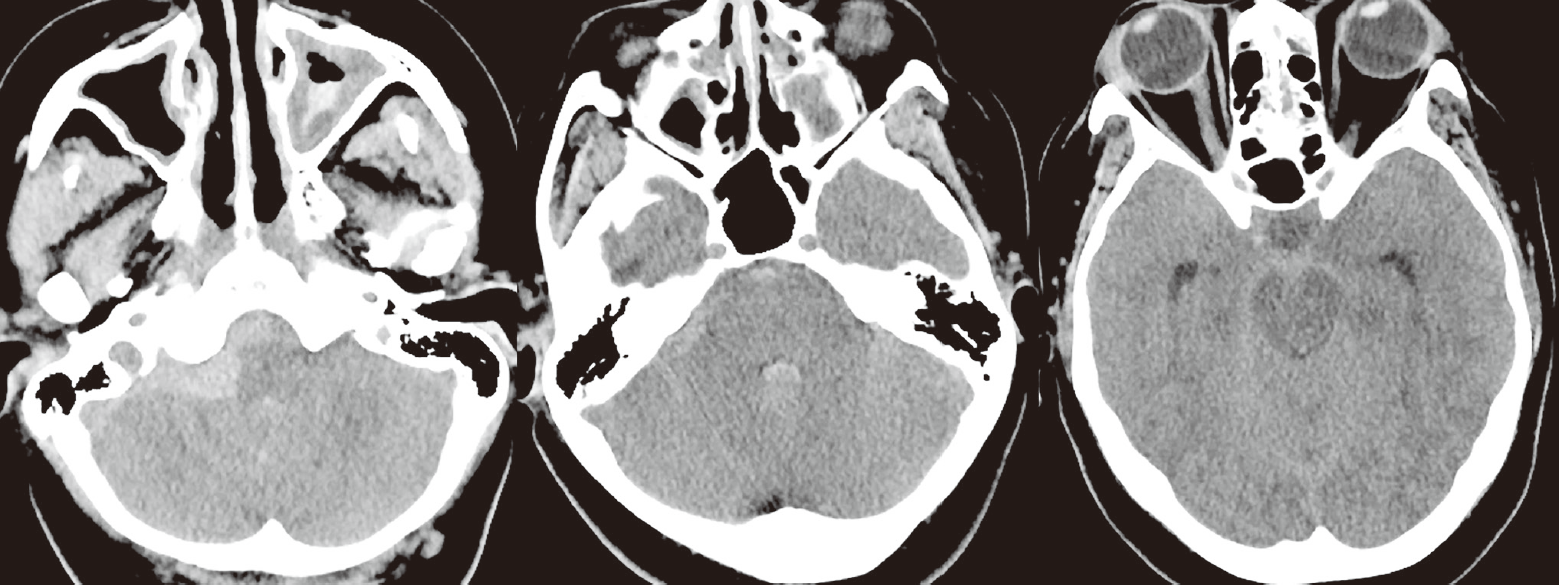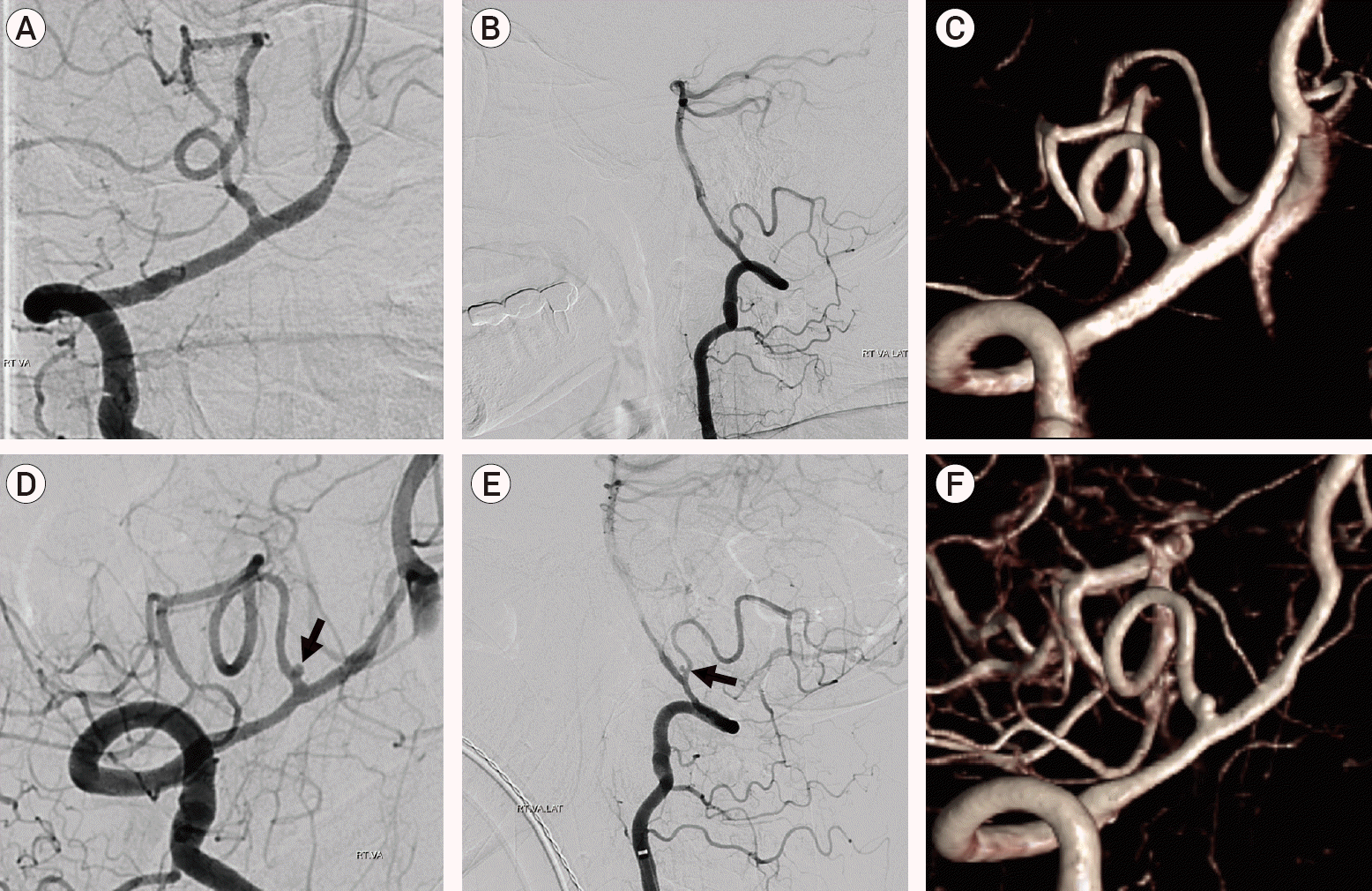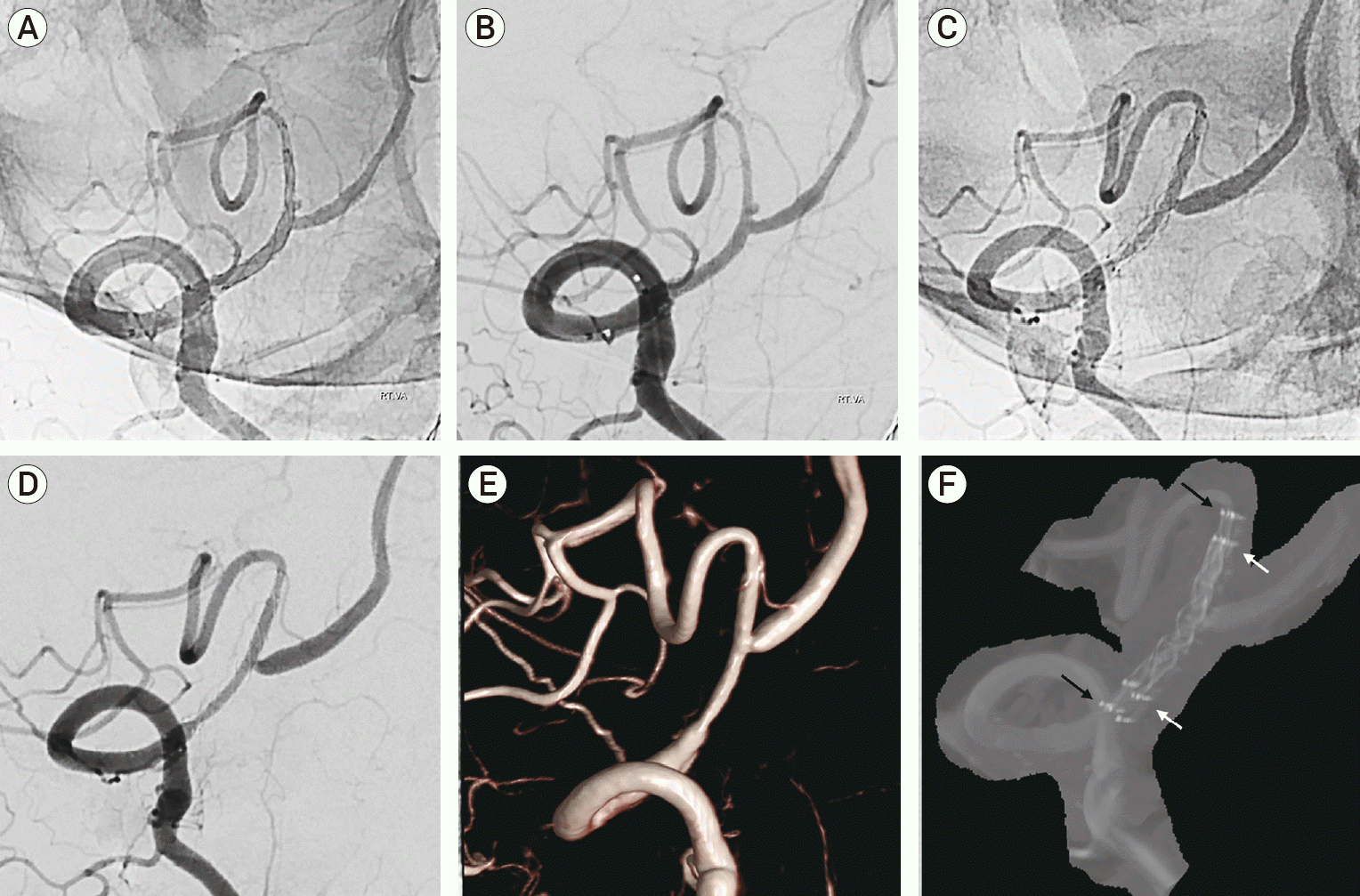Abstract
Dissecting aneurysm involving the posterior inferior cerebellar artery (PICA) are challenging because of its nature and anatomic relationship to medulla and lower cranial nerve. We introduce a case of ruptured dissecting aneurysm located at the proximal PICA treated with telescoping stents for flow diversion and dissection healing. A 49 years old female visited to the emergency room for ruptured dissecting aneurysm at right proximal PICA. Telescoping stent was deployed along the right vertebral artery to PICA covering the dissecting aneurysm bleb using two Low-profile Visualized Intraluminal Support Jr (LVIS Jr) stents. Three months follow up angiography revealed a disappearance of aneurysm bleb and healing of dissection by parent artery remodeling. Telescoping stent with LVIS Jr may be an effective treatment for dissecting aneurysm with small diameter (<2 mm) parent artery. Convenient navigation and targeted telescoping stent for minimizing metal coverage at perforating arteries are an advantage for this method.
The aneurysm located at posterior inferior cerebellar artery (PICA) account for about 0.5 to 3% of all intracranial aneurysm [6,8]. Dissecting feature or fusiform dilatation is more likely detected at the vertebral artery (VA) and PICA compared to other location. Treatment of pseudo-aneurysm involving the PICA orifice or PICA body is challenging because of its relationship to brainstem and lower cranial nerve.
Parent artery occlusion is the best choice for ruptured pseudo-aneurysm to avoid re-bleeding. However, occlusion of PICA can cause posterolateral medulla infarction (Lateral medullary syndrome) which present as dysphagia and loss of pain and temperature sensation at contralateral body and ipsilateral face.
For dissecting aneurysm involving PICA, microsurgical repair of aneurysm with arterial bypass is an option, but contains high risk of surgical complication [14]. Parent artery remodeling via flow diversion can minimize the risk for ischemia, but have to bear the risk of re-bleeding. High anatomic variation and artery tortuosity of PICA makes it more difficult to treat the aneurysm.
We introduce a case of ruptured dissecting aneurysm located at the anterior medullary segment of PICA which is treated with telescoping stent. Two Low-profile Visualized Intraluminal Support Junior (LVIS Jr) stent were deployed along VA to PICA covering the dissecting bleb of proximal PICA.
A 49 years old female with underlying Sjogren syndrome has visited to emergency room for severe headache, posterior neck pain, and projectile vomiting. Brain computed tomography revealed a subarachnoid hemorrhage located mainly at right cerebello-medullary cistern and intraventricular hemorrhage (Fig. 1). Trans-femoral cerebral angiography was performed at the day of symptom onset, but no aneurysm was detected. Four days later at follow up cerebral angiography, small bulging aneurysm (1.7×1.5×1.0 mm with 2.0 mm sized neck, Fig. 2) appeared at the sidewall of anterior medullary segment of right PICA. Furthermore, right VA diameter has decreased from 3.1 mm to 2.3 mm, which could be a sign of dissection or vasospasm. The diameter of proximal PICA was 1.8 mm (Fig. 2) and no perforating vessels were visible near the junction of VA and PICA.
Loading dose of dual antiplatelet (aspirin 300 mg and clopidogrel 300 mg) was administrated via the nasogastric tube during the general anesthesia for endovascular treatment. First, LVIS Jr (2.5×23 mm) stent was deployed from the VA to PICA via Headway 17 microcatheter (Microvention Inc., Tustin, CA, USA). Additional LVIS Jr (2.5×17 mm) stent was deployed inside the indwelling stent to achieve flow diversion effect (Fig. 3A, B). Coil insertion was not attempted due to the risk of aneurysm rupture. There were no procedural complication or newly developed neurologic deficits after the treatment. Patient was tolerable with dizziness and mild headache. Dual antiplatelet (aspirin 100 mg and clopidogrel 75 mg) was administrated for 6 months after the procedure.
After three months, cerebral angiography showed disappearance of aneurysm and good patency of PICA (Fig. 3C, D). The diameter of right VA has decreased due to intimal hyperplasia at the site of stent deployment. Straightening of PICA (increase of angle between VA and PICA) developed and the diameter of PICA has increased (1.8 mm before treatment and 2.4 mm after treatment) with good flow patency. The patient returned to work without neurological sequelae.
We demonstrated a case of dissecting aneurysm located at the anterior medullary segment of PICA which is treated successfully with telescoping LVIS Jr stent along the right VA to PICA. Telescoping stent with LVIS Jr at small diameter PICA maintained good flow patency and ultimately healed the dissection. Even though two LVIS Jr stents were inserted into a small diameter artery (1.8 mm), the straightening effect of PICA and radial force of the stent contributed to good flow patency and healing of dissection.
Recent technical advancement of endovascular treatment allowed the use of intracranial stent to small diameter artery. Single low-profile stent deployment for small diameter artery (2-3 mm) is known to be safe and effective, which is usually used for stent assisted coil embolization for distal cerebral aneurysm such as anterior communicating artery and middle cerebral artery aneurysm [3,5,8,12]. However, dual stent deployment in a small diameter artery is rare and the risk has not been widely evaluated. Akmangit et al. introduced a case of fusiform aneurysm of PICA well treated with two telescoping stent with LEO Baby (Balt, Montmorency, France) [1]. Anil et al. described three cases of dissecting distal cerebellar artery aneurysms treated with telescoping stents with LVIS Jr [2]. All three patients follow-up image confirmed occlusion of the aneurysm with patent parent arteries.
Aneurysm involving the PICA orifice and PICA trunk are various with its character (saccular or fusiform) and anatomic course. Srinivasan et al. classified the aneurysm involving PICA with character and location to plan treatment strategy with flow diverter stent [13]. Fusiform aneurysm involving the VA or the proximal PICA (<2 cm) were suggested to treat by flow diverter stent placed at VA. Fusiform aneurysm that begins distal to PICA-VA junction allowing sufficient landing zone (usually at least 5 mm) at PICA itself was suggested to treat by flow diverter stent within the PICA itself. Deploying the stent only in the PICA has the advantage of avoiding oversized stent because VA diameter is not considered for stent diameter choice. However, it is technically difficult to deploy the stent in exact desired location and the risk of recurrence is high when arterial dissection begins from the VA.
Oğuz and Dinc demonstrated a treatment of proximal PICA aneurysm treated with flow diverter stents deployed only at VA covering the PICA origin [10]. The concept of this treatment is to reduce the blood flow to PICA and induce healing process of dissecting aneurysm. Among four patients with ruptured PICA aneurysm, one patient experienced re-bleeding which have died. We believe that flow diversion for only VA is not enough for ruptured PICA dissecting aneurysm. Reducing the blood flow to PICA is not enough for ruptured dissecting aneurysm because of its high re-rupture rate. Treatment target should include the rupture site of dissecting aneurysm.
Deploying coils into the pseudo-aneurysm sac may lower the risk of re-bleeding by inducing thrombosis. However, the risk for procedural rupture is high due to fragile wall and tortuous parent artery. PICA aneurysm is known to be related with high procedural rupture rate because of small diameter parent artery and tortuosity [11]. In our case, we did not attempt to navigate the microcatheter to aneurysm sac due to small aneurysm size. We determined that the risk of procedural rupture during coil insertion was higher than the re-bleeding risk after flow diversion without coil insertion to aneurysm sac.
Interesting finding of our case is that the diameter of proximal PICA has increased about 30% after telescoping stent with LVIS Jr. The most concerning problem in multiple stent insertion into a small diameter artery is the occlusion of parent artery by thromboembolism. After telescoping stent from VA to PICA, straightening effect of PICA and the radial force of the stent contributed to 30% increase of PICA diameter. Chung et al. reported the increase of vessel diameter after placement of oversized closed cell type stent in small arteries less than 2 mm with good patency [5]. The diameter of PICA is usually less than 2 mm and no intracranial stents are designed for these vessel. Therefore, it is always an oversizing stent for PICA either flow diverter or conventional stents. Oversizing of stents will result in prolonged lengthening and reduced metal coverage. Unpredictable landing zone estimation and reduced metal coverage should be considered for PICA stenting. We believe multiple stent insertion for small diameter artery is not a problem in itself, but care should be taken for excessive tension induced by vessel straightening and improper wall apposition for acute angle vessel. However, the diameter of VA has narrowed during the follow up, which is expected to be related to intimal hyperplasia. Wall apposition of the stent at VA seems to be not enough due to undersized stent (2.5 mm) compared to VA. It appears that undersized stent at VA caused intimal hyperplasia to fill the gap between endothelium and stent.
Several case series have showed good results for the treatment of small diameter dissecting aneurysm with flow diverter stents [4,7,9,13]. Recent development of small diameter flow diverter has allowed effective and safe treatment of distal aneurysm such as A2, M2, or distal cerebellar arteries. LVIS Jr stent delivery system is a low profile, closed cell, braided nitinol wire stent which can be delivered in 0.017 inch microcatheter. Telescoping stents with LVIS Jr can achieve flow diverting effect and has advantage of convenient navigation to small diameter artery using the small delivery system compared to flow diverter stents. Furthermore, stent-in-stent treatment with LVIS Jr allows high metal coverage at the targeted area while preventing excessive coverage of perforating vessels.
Flow diversion via LVIS Jr telescoping stent for dissecting aneurysm located at small diameter (<2 mm) artery could be an effective method for aneurysm healing while maintaining the patency of parent artery. Convenient navigation and targeted short segment flow diversion are the advantage of telescoping LVIS Jr stents compared to flow diverters.
REFERENCES
1. Akmangit I, Aydin K, Sencer S, Topcuoglu OM, Topcuoglu ED, Daglioglu E, et al. Dual stenting using low-profile LEO baby stents for the endovascular management of challenging intracranial aneurysms. AJNR Am J Neuroradiol. 2015; Feb. 36(2):323–9.

2. Anil G, Sein L, Nga V, Teo K, Chou N, Yeo TT. Dissecting distal cerebellar artery aneurysms: options beyond a parent vessel sacrifice. Neurosurg Rev. 2020; Apr. 43(2):771–80.

3. Behme D, Weber A, Kowoll A, Berlis A, Burke TH, Weber W. Low-profile Visualized Intraluminal Support device (LVIS Jr) as a novel tool in the treatment of wide-necked intracranial aneurysms: initial experience in 32 cases. J Neurointerv Surg. 2015; Apr. 7(4):281–5.

4. Bhogal P, Chudyk J, Bleise C, Lylyk I, Henkes H, Lylyk P. The use of flow diverters to treat aneurysms of the posterior inferior cerebellar artery: Report of three cases. Interv Neuroradiol. 2018; Oct. 24(5):489–98.

5. Chung J, Suh SH, Hong CK, Joo JY, Lim YC, Shin YS, et al. Preliminary experience with self-expanding closed-cell stent placement in small arteries less than 2 mm in diameter for the treatment of intracranial aneurysms. J Neurosurg. 2015; Jun. 122(6):1503–10.

6. Lewis SB, Chang DJ, Peace DA, Lafrentz PJ, Day AL. Distal posterior inferior cerebellar artery aneurysms: clinical features and management. J Neurosurg. 2002; Oct. 97(4):756–66.

7. Martin AR, Cruz JP, O’Kelly C, Kelly M, Spears J, Marotta TR. Small pipes: preliminary experience with 3-mm or smaller pipeline flow-diverting stents for aneurysm repair prior to regulatory approval. AJNR Am J Neuroradiol. 2015; Mar. 36(3):557–61.

8. Mericle RA, Reig AS, Burry MV, Eskioglu E, Firment CS, Santra S. Endovascular surgery for proximal posterior inferior cerebellar artery aneurysms: an analysis of Glasgow Outcome Score by Hunt-Hess grades. Neurosurgery. 2006; Apr. 58(4):619–25. discussion 619-25.

9. Möhlenbruch MA, Kizilkilic O, Killer-Oberpfalzer M, Baltacioglu F, Islak C, Bendszus M, et al. Multicenter experience with FRED Jr flow re-direction endoluminal device for intracranial aneurysms in small arteries. AJNR Am J Neuroradiol. 2017; Oct. 38(10):1959–65.

10. Oğuz Ş, Dinc H. Treatment of posterior inferior cerebellar artery aneurysms using flow-diverter stents: A single-center experience. Interv Neuroradiol. 2019; Aug. 25(4):407–13.

11. Peluso JP, van Rooij WJ, Sluzewski M, Beute GN, Majoie CB. Posterior inferior cerebellar artery aneurysms: incidence, clinical presentation, and outcome of endovascular treatment. AJNR Am J Neuroradiol. 2008; Jan. 29(1):86–90.

12. Santillan A, Boddu S, Schwarz J, Lin N, Gobin YP, Knopman J, et al. LVIS Jr. stent for treatment of intracranial aneurysms with parent vessel diameter of 2.5 mm or less. Interv Neuroradiol. 2018; Jun. 24(3):246–53.
Fig. 1.
Noncontrast brain computed tomography at the day of symptom onset. Subarachnoid hemorrhage was noted and dominant at right cerebello-medullary cistern. Intraventricle hemorrhage was also appeared at the fourth ventricle.

Fig. 2.
Change of digital subtraction angiography between the day of subarachnoid hemorrhage (A, B, C) and follow up image which was taken four days later (D, E, F). Small dissection aneurysm bleb (black arrow) was noticed on the follow up image located at the anterior medullary segment of right posterior inferior cerebellar artery.

Fig. 3.
(A, B) Right vertebral arteriography after the deployment of telescoping stent with LVIS Jr along the right VA and posterior inferior cerebellar artery. (C, D) Three months follow up cerebral angiography after the telescoping stent insertion. (E, F) Three months follow up digital subtraction and MIP image showing disappearance of dissection aneurysm bleb and healing of dissection (black arrow: proximal and distal tip of LVIS Jr 2.5×23 mm, white arrow: proximal and distal tip of LVIS Jr 2.5×17 mm). LVIS Jr, Low-profile Visualized Intraluminal Support Jr; VA, vertebral artery; MIP, maximum intensity projection.





 PDF
PDF Citation
Citation Print
Print



 XML Download
XML Download